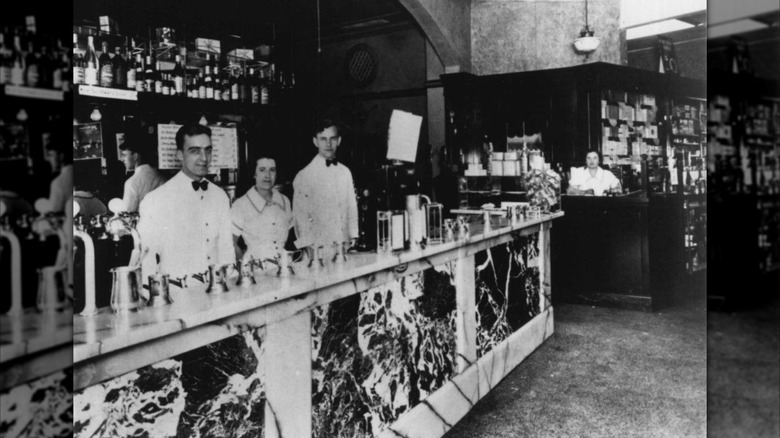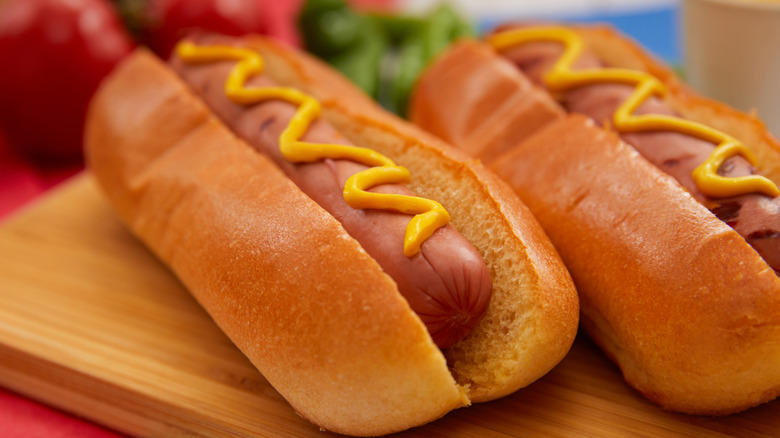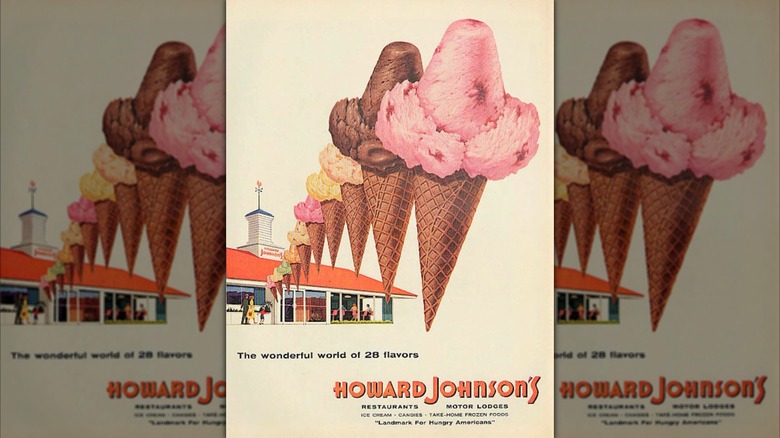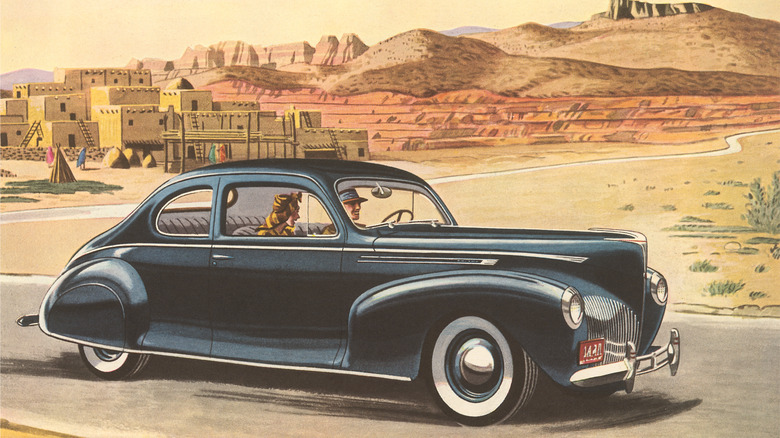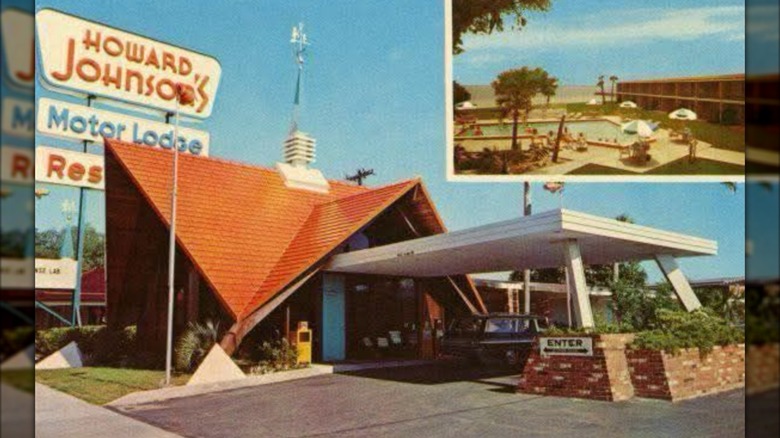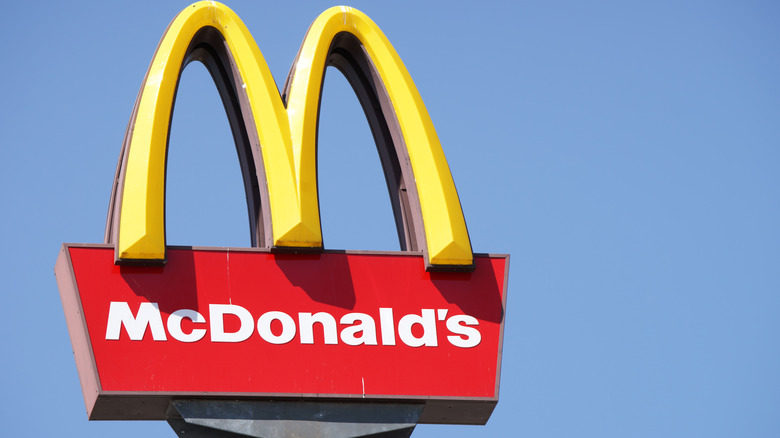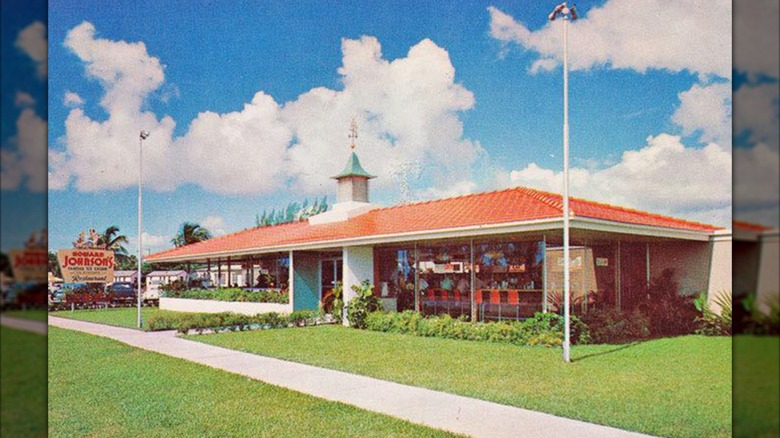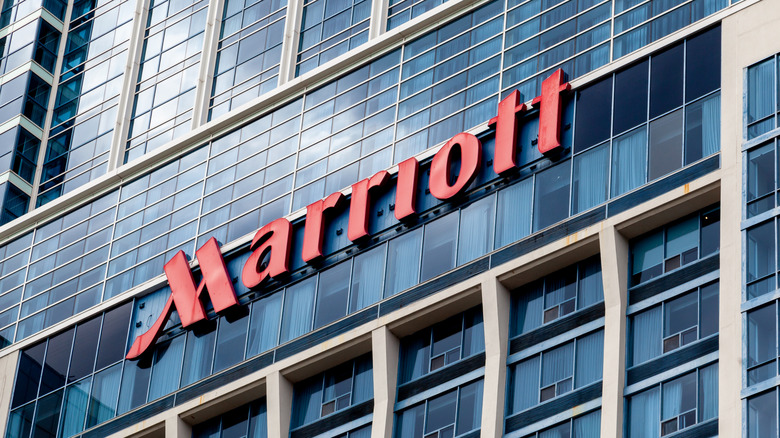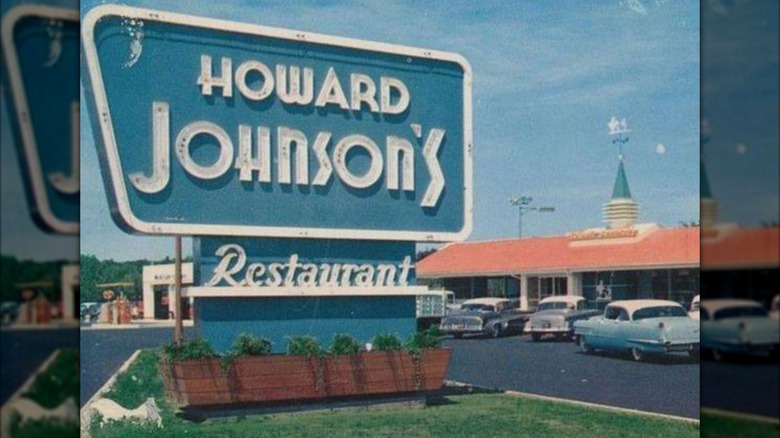The Rise And Fall Of America's Biggest Restaurant Chain: What Went Wrong?
Before there were countless chain restaurants across the globe, there was Howard Johnson's. This chain, that virtually no one remembers anymore, was at one point the largest restaurant business in the United States. At its peak it boasted over 1,000 locations, and like so many other American success stories, it grew from humble beginnings to become a titan of the industry it operated in. Simultaneously, it pioneered franchising, a business style that's become the standard way of working for many chain restaurants across the land, and yet somehow managed to remain a company that felt homey and familiar.
However, if you're looking for a Howard Johnson's anywhere today, you'll be sorely disappointed. The chain that once had a unit sitting next to every highway in the country is now nowhere to be seen, thanks to a host of sell-offs, changes in consumer behavior and tastes, and other businesses muscling it out of the market for good. Nonetheless, it serves as an intriguing case study both in how to build a business, and in how to stop it from evaporating from the face of the earth. Let's take a deep dive into the tale of Howard Johnson's, a long-lost American icon.
Howard Johnson's started as a single drugstore
The classic story of successful restaurant chains is usually pretty familiar. It usually starts with one person, a single business, and a dream, with that dream eventually propelling their humble idea to stratospheric heights. Nowhere is that story as clear as with Howard Johnson's, which started life way back in 1925 as a soda fountain. The restaurant was founded by its namesake Howard Deering Johnson, who was faced with a large amount of debt after taking on his late father's cigar business a couple years before. Johnson took a risk and incurred a further debt of $500 by putting down the cash for a combined drugstore and soda fountain in Wollaston, Massachusetts, a neighborhood in Quincy located just south of Boston.
Although Johnson's store was initially unprofitable, he struck gold when he figured out what would get people through the door: Ice cream. Johnson realized that if he made higher-quality ice cream by increasing the level of butterfat, he'd create a product that stood apart from the other parlors in the area. He was right: His ice cream recipe was an immediate success, and within a couple of years, his debts were paid off. At the same time, Johnson was eyeing expansion.
Howard D. Johnson's embracing of popular foods saw his initial business boom
Alongside Howard D. Johnson's famous ice cream recipe, he was also considering how he could pivot his business from a simple soda stand to a full-on eating experience. He had previous experience in trying out new versions of his business, with an ice cream stand on Wollaston Beach selling his products to great success. In 1929, he took the plunge, opening his first full-service restaurant (and in essence, the very first proper Howard Johnson's). Johnson implemented all of the lessons that he had learned in the previous few years, which had also been seeing him experiment with serving new foods like fried clams and hot dogs to his customers. Some of these menu items, like the aforementioned clams (which started as a joke), became staples at Howard Johnson's restaurants in the years to come.
Johnson's very first eatery initially paid dividends, with people flocking to the restaurant in their droves. The future looked bright for this budding entrepreneur — but then, disaster struck. The stock market crash in October 1929 wreaked havoc on the economy, and on Johnson's plans to expand his business. Although Howard Johnson's managed to hang on and keep surviving, it did so by the skin of its teeth.
During the Great Depression, Johnson pioneered the franchising model
The 1930s wasn't a great time for most Americans, and for the first half of the decade, it wasn't great for the founder of Howard Johnson's either. He had once again found himself in debt, and although his restaurant was still in operation, he needed to figure out a way to scale operations. He did so by applying the franchising model to his business. In 1935, he bargained with a local businessman, who agreed to rebrand his restaurant as a Howard Johnson's in exchange for a fee and a streamlining of business operations. When the move was a success for both of them, other people started working with Johnson in the same way, and the brand's name began to grow.
Franchising wasn't a new idea, but Johnson's application of it to a fully operable restaurant (as opposed to a soda or hot dog stand) was unique at the time. Its success showed people that it could be done, and Johnson himself started to seriously benefit. Howard Johnson restaurants (and ice cream stands) started to number in the double digits, and then the dozens. By the end of the 1930s, its presence was pretty big.
In the 1940s, Howard Johnson's really took off — thanks to the rise of the car
Howard Johnson's wasn't the only thing growing in popularity during the first half of the 20th century. The other thing that was really making the splash was the car. The automobile industry had been steadily growing since the early 1900s, and the '20s and '30s saw competitors jostle with each other, thereby giving budding motorists way more choice. As the country came out of the Great Depression and motoring picked up, Johnson cannily started to strike deals that allowed him to build his restaurants at key roadside locations and service areas.
The Second World War, however, caused another disruption to Johnson's business, with leisure travel rapidly contracting. Johnson had to pivot once more, establishing contracts with the government to feed soldiers with his food. Although a large proportion of Howard Johnson's restaurants closed during these war years, when it was over the businessman resumed his expansion across the highways of America. By the end of the 1940s and start of the 1950s, his restaurants were once again everywhere, and they became must-visit locations on long road trips. There were plenty of diners to see along Route 66, but Howard Johnson's was always a worthwhile stop.
Its motor lodge concept saw sales explode
The 1950s were a good decade for Howard Johnson's. The restaurant was raking in the cash, and it had hundreds of locations across the country. Legislation that ushered in the creation of the interstate system was also music to Howard D. Johnson's ears, who foresaw a world where his restaurants were dotted across every major road in the entire country. Then, Johnson realized that all of these motorists needed places to stay — and if he could offer that as well as a hot meal, he'd basically be printing money.
As such, Johnson premiered his motor lodge concept in 1954, with the first opening in Savannah, Georgia. You could park your car at the end of a long day's driving, eat at a Howard Johnson's, and then head next door and sleep in one of its lodges. Like the restaurants themselves, the lodges were all virtually identical to each other, giving customers a sense of familiarity and reassurance in what they were getting. This masterstroke of a business move drove Howard Johnson's expansion even more, and dozens upon dozens of new locations followed.
Other franchises contributed to Howard Johnson's success
Howard Johnson's restaurants may have been everywhere by the middle of the 20th century, but it wasn't content to just operate one brand. Instead, the company also had several other franchises, which increased the overall presence and market domination of the business and kept the money rolling on. The most significant of these franchises was Red Coach Grill, which was bought by Howard D. Johnson way back in the 1930s. While Howard Johnson's specialized in old-school, affordable food, Red Coach Grill's concept was to offer diners an upscale steakhouse experience.
Like Howard Johnson's, Red Coach Grill first started its life in Massachusetts, but by the 1960s it had seriously expanded, with restaurants in New York and Miami. By 1975, the business had 32 locations. In 1969 Howard Johnson's had also opened another franchise, The Ground Round, which caught on pretty quickly: By 1975 and in just six years, the pub-style eatery had grown to 63 units. Howard Johnson's, meanwhile, had an enormous 929 restaurants and 536 motor lodges.
During the 1960s and '70s, other fast food restaurants started to threaten Howard Johnson
There's no denying that in mid-century America, Howard Johnson's was the king of all restaurants. However, that throne was coming under serious threat from a host of competitors. There were some new kids on the block, and other American fast food restaurants like McDonald's, Burger King, Wendy's, and KFC were getting a piece of the franchise action, to great effect. Starting in the 1960s, these nimble restaurant businesses started to threaten Howard Johnson's supremacy, and although it was still outselling all of them, things were getting tense for the company.
These newer businesses had one key advantage over Howard Johnson's: Speed. Although Howard Johnson's traditional table service vibe was comforting and considered, it also slowed down operations considerably. Meanwhile, McDonald's and Burger King were able to stack their burgers high and sell them quickly. By the middle of the 1970s, Howard Johnson's was looking like it was struggling to keep up — and some behind-the-scenes moves saw its fortunes fall even further in the coming years.
A succession of sales saw Howard Johnson's start to decline
The 1970s and '80s saw things go from bad to worse for this business. Although Howard Johnson's restaurant numbers continued to rise, reaching over 1,000 by 1979, it was starting to feel the strain of its food prices. Howard D. Johnson's son (also named Howard Johnson, and more commonly known as Bud), who had taken over the family business, had to try and find ways to cut costs, and the quality of its output began to take a turn for the worse. Howard Johnson's reputation started to suffer, with people considering it to be cheap and dirty.
Bud then decided that he wanted out, and sold the business to the Imperial Group, a British company that formerly traded in tobacco. Over the next six years, the Imperial Group made a series of decisions to improve Howard Johnson's which all backfired, further tanking its reputation. In 1985 it decided that it had enough and subsequently sold the business, this time to Marriott, at half the cost of what it originally purchased it for. The writing was on the wall, and this restaurant was now facing some bleak years ahead.
Once Marriott bought Howard Johnson's, its days were numbered
The sale of Howard Johnson's to Marriott should have given the flailing restaurant chain a shot in the arm. However, it had the total opposite effect, due to Marriott's complete lack of desire to maintain the reputation and presence of the restaurant business. Marriott had ambitions of its own to become the premium destination for folks to stay while they were on the road, and by buying Howard Johnson's it was somewhat eliminating the competition. It sold its motor lodges to Prime Motor Inns in 1985 (the same year that it had bought it) for $235 million. By this time, Howard Johnson's had just 174 restaurants left, after Marriott had sold off and converted multiple locations.
There was a glimmer of hope for Howard Johnson's here to make a comeback, and indeed Prime Motor Inns began investing heavily in the brand. Sadly, though, after a few years of trying to get it back in business, it gave up the ghost. In 1986, both Marriott and Prime were sued by a group of unhappy franchisees. Then, in 1990, Prime sold a large chunk of its Howard Johnson's locations to Blackstone Capital. While the restaurant and motor lodge business managed to hang on for a while, Howard Johnson's was starting to die.
As the 21st century rolled on, Howard Johnson's died for good
As the '90s trucked along and the world started to look towards a dawning millennium, one thing became clear: That new world would have no place for Howard Johnson's in it. What was once a titan of its industry had shrunk to just 84 locations in 1995. A decade later it had a grand total of eight restaurants. The Howard Johnson's that were still in operation at this time, which were sometimes staffed by folks who had been working there for decades, became a shell of their former glory, with streamlined menus and dwindling customer numbers.
By this point, there was no denying it: Howard Johnson's was on the way out. One by one, the remaining handful of restaurants shut their doors, and in 2022 the final location in Lake George, New York, shut for good. With that closure came the end of a long, strangely emotional story of ambition, hospitality, and the decline of a colossus. Thanks for all the memories, Howard Johnson's.

